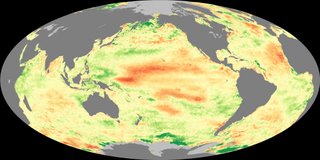Warming Ocean Slows Phytoplankton Growth

Every day, more than 100 million tons of carbon dioxide are drawn from the atmosphere into the ocean by billions of microscopic ocean plants called phytoplankton during photosynthesis. In addition to playing a big role in removing greenhouses gases from the atmosphere, phytoplankton are the foundation of the ocean food chain.

For nearly a decade, the Sea-viewing Wide Field-of-View Sensor (SeaWiFS) has been making global observations of phytoplankton productivity. On December 6, 2006, NASA-funded scientists announced that warming sea surface temperatures over the past decade have caused a global decline in phytoplankton productivity. This pair of images shows changes in sea surface temperature (top) and phytoplankton productivity (bottom) between 2000 and 2004, after the last strong El Niño event, which occurred between 1997-1998. Places where temperatures rose between 2000 and 2004 (red areas, top image) are the same places where productivity dropped (red areas, bottom image). In general, the reverse situation was also true: where temperatures cooled, productivity rose. The sea surface temperature map is based on data collected by the Advanced Very High Resolution Radiometer (AVHRR) sensors onboard several National Oceanic and Atmosphere Administration satellites.
from NASA's Earth Observatory Newsroom


0 Comments:
Post a Comment
<< Home